Physical Address
304 North Cardinal St.
Dorchester Center, MA 02124
The subaxial cervical spine is composed of the C3 through C7 vertebrae. Epidemiologic studies have shown that cervical spine fractures or dislocations occur in 2% to 3% of trauma patients. However, injuries to the subaxial cervical spine account for 65% of all cervical spine fractures and more than 75% of dislocations, with C6 being the most commonly fractured subaxial vertebra and C5–C6 being the most commonly dislocated level.
Historically, debate has existed on the proper classification and treatment of subaxial cervical spine injuries. Little evidence existed for the best form of treatment for subaxial cervical spine injuries; however, more recent evidence-based classification and treatment systems have brought us closer to a more systematic way of evaluating and treating subaxial injuries. The recently introduced AOSpine Subaxial Cervical Spine Injury Classification System provides a comprehensive and reproducible evaluation system that considers injury and patient characteristics. This chapter provides an understanding of different types of subaxial cervical spine trauma and evidence-based methods of treating them.
There is a wide range of injury patterns and severity of subaxial cervical spine injuries.
These injuries are often caused by high-energy trauma and may be associated with noncontiguous spinal injuries and other life-threatening injuries. Full Advanced Trauma Life Support (ATLS) protocols should be followed.
The AOSpine Subaxial Classification system has been introduced to comprehensively classify subaxial injuries. It considers the stability of the injury, morphology, the neurologic status of the patient, and relevant anatomic and bony conditions such as the presence of a critical disc herniation, vertebral artery injury, or significant metabolic derangement such as ankylosing spondylitis (AS) or diffuse idiopathic skeletal hyperostosis (DISH). In general, type A injuries are treated nonoperatively, type C injuries are treated operatively, and type B injuries may or may not be treated with surgery.
The Subaxial Cervical Spine Injury Classification (SLIC) is both a classification system and a scoring system that helps guide treatment decisions regarding operative versus nonoperative management.
Closed reduction of jumped or perched facet dislocations and/or fractures may be performed with the patient awake and cooperative to minimize the risk of neurologic compromise from the reduction maneuver.
Standard anterior and posterior surgical approaches and reconstruction techniques are employed to reduce injuries, decompress neural elements, and stabilize the levels affected.
The osseous anatomy of the subaxial cervical spine is relatively constant, with the exception of C7, which is a transitional vertebra at the cervicothoracic junction. The posterior vertebral body ventrally, the pedicles laterally, and the laminae posteriorly form the boundaries of the spinal canal ( Fig. 32.1 ). Each vertebral body has an endplate superiorly and inferiorly. As the superior endplate extends from midline laterally, it slopes upward to form the uncinate process. The uncovertebral joint of Luschka is formed by the concave uncinate process of the inferior vertebra with the convex lateral inferior endplate from the suprajacent vertebral body. This is an important landmark when performing anterior discectomy or corpectomy.
![Fig. 32.1, Osseous anatomy of the subaxial cervical spine. (A) Typical vertebral body viewed from above. (B) Viewed from left side. Cervical pedicles (6) are very short and extend at a medial angle from the superior articular process (1) . The lateral mass (consisting of the superior [1] and inferior [7] articular processes] is rhomboid in shape when viewed from the lateral view. The superior surface of the vertebral body (5) is raised at the posterolateral corners to form the uncovertebral joints. Fig. 32.1, Osseous anatomy of the subaxial cervical spine. (A) Typical vertebral body viewed from above. (B) Viewed from left side. Cervical pedicles (6) are very short and extend at a medial angle from the superior articular process (1) . The lateral mass (consisting of the superior [1] and inferior [7] articular processes] is rhomboid in shape when viewed from the lateral view. The superior surface of the vertebral body (5) is raised at the posterolateral corners to form the uncovertebral joints.](https://storage.googleapis.com/dl.dentistrykey.com/clinical/SubaxialCervicalSpineTrauma/0_3s20B978032361114500032X.jpg)
The transverse process extends from the pedicle laterally and anterior to the lateral mass. Unique to the cervical spine, within the transverse processes is the foramen transversarium, through which the vertebral artery typically ascends, beginning at C6. This particular anatomic feature allows for safer placement of pedicle screws into C7.
Another feature of the vertebrae unique to the cervical spine is the lateral mass. The lateral mass forms the dorsal surface of the vertebra lateral to the lamina. The lateral mass superiorly is bordered by the superior articular process and inferiorly by the inferior articular process. The subaxial cervical facets are oriented like shingles on a house. Specifically, the inferior articular facet of the cephalad vertebra is dorsal to the superior articular facet of its infrajacent vertebra ( Fig. 32.2 ). The lamina borders the lateral mass medially, which then slopes posteromedially, converging with the contralateral lamina to form the spinous process. Cervical spinous processes are often bifid except for C7. C7 typically has the most prominent spinous process of the subaxial cervical spine and is usually an easily palpable landmark.
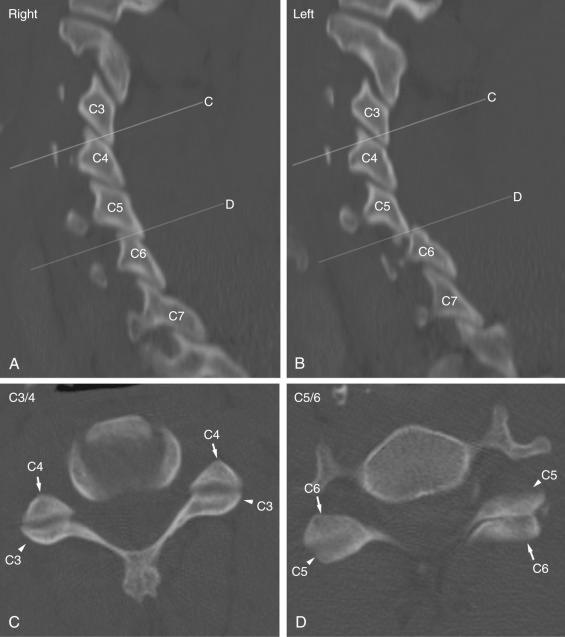
The intervertebral disc borders the respective endplates of the superior and inferior vertebrae. It contributes significantly to the stability of the vertebral-disc motion segment. The nucleus pulposus is at the center of the disc, and surrounding this is the tougher and more fibrous annulus fibrosis.
Anterior elements are the anterior longitudinal ligament (ALL), intervertebral disc, vertebral body, intertransverse ligament, and posterior longitudinal ligament (PLL). The ALL runs longitudinally along the entire length of the spine anterior to the vertebrae. The ALL and the anterior vertical fibers of the annulus fibrosis serve as important restraints to hyperextension. These anterior annular fibers typically fail in extension before the failure of the stronger ALL.
The PLL runs longitudinally along the posterior aspect of the vertebral bodies along the entire length of the spine. Because of its more posterior location, the PLL resists flexion moments with a strength similar to that of the ALL. The PLL thins laterally, and the posterior annular fibers are relatively weak in comparison to anterior annular fibers at the same level, which likely contributes to the relatively common occurrence of disc protrusions and herniations in this region ( Fig. 32.3 ).
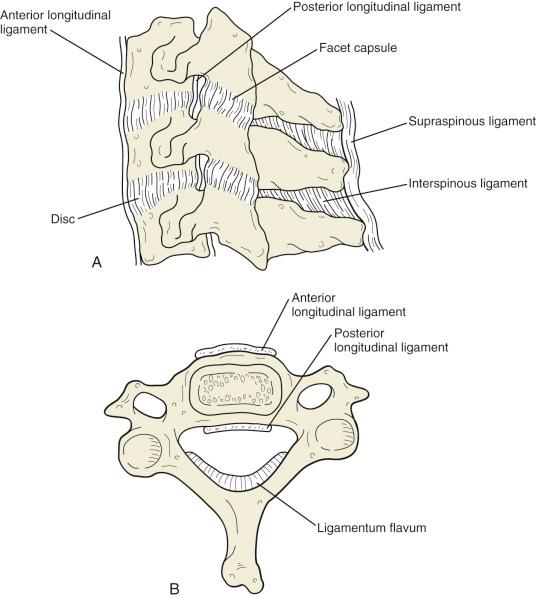
The posterior elements are defined as those structures posterior to the PLL. These include the facets, laminae, and spinous process as well as the associated soft tissue structures: the ligamentum flavum, facet capsules, and interspinous and supraspinous ligaments. The ligamentum flavum extends from the anteroinferior surface of one lamina to the superoposterior surface of the inferior lamina. Although elastic in young people and resistant to flexion, the ligamentum hypertrophies and stiffens with the aging process and may be a source of posterior impingement with hyperextension injuries.
The cervical facet capsules in this region are patulous and do not restrict motion until extremes of flexion are reached.
The ligamentum nuchae is a triangular fibrous membrane that overlies the supraspinous and interspinous ligaments and runs between the external occipital protuberance of the skull and the spinous process of C2 and C7. When the ligamentum nuchae was resected in a cadaveric model, cervical spine stiffness decreased by 27% and flexion increased by 28%, indicating the importance of this structure as a stabilizing force. The ligamentum nuchae, infraspinous ligaments, and supraspinous ligaments are restraints to flexion.
Under normal physiologic conditions, the human cervical spine is mobile, allowing a high degree of flexibility and rotational movement. However, the same reasons that the cervical spine is so mobile also contribute to its susceptibility to indirect injury mechanisms. Most motion in the cervical spine is from occipitocervical (O–C1) and atlantoaxial motion (C1–C2). In vitro cadaveric studies have demonstrated that each level of the normal subaxial cervical spine contributes 8 to 10 degrees of flexion and 3 to 5 degrees of axial rotation. In vivo magnetic resonance imaging (MRI) studies of healthy volunteers have found between 1.5 and 4.6 degrees of axial rotation at each subaxial level and lateral bending at each level to be between 1.9 and 5.7 degrees. C2–C3 has the most lateral bending at about 5 degrees; however, this is not significantly different from that at other cervical levels.
White and Panjabi defined spinal instability as “the loss of the ability of the spine under physiologic loads to maintain its pattern of displacement so that there is no initial or additional neurologic deficit, no major deformity, and no incapacitating pain.” Much of the stability of the subaxial spine is based not on osseous structures but on the ligaments and other soft tissue structures that hold them in place. For example, a dislocated facet joint is considered unstable even after closed reduction because the ligaments and capsule holding the joint in place have been disrupted and are not expected to heal with the strength needed to maintain stability with physiologic motion.
In the absence of obvious dislocation or subluxation, destabilizing injuries in the subaxial spine can be subtle. Spinal imaging, whether plain radiographs, computed tomography (CT) scan, or MRI, is often static. These imaging studies do not show the spine under conditions of motion, under loading, or at the moment of injury. Flexion and extension lateral radiographs are effective at showing instability but are not typically performed in the acute injury period. Therefore other ways are needed for deciding whether or not a cervical spine injury is a stable injury. Furthermore, the concept of cervical spine stability versus instability may be a spectrum of stability rather than a clear-cut division. These concepts make diagnosing and effectively treating subaxial cervical spine injuries challenging and at times controversial. Several classifications have been introduced over the past several years to help the treatment team decide on the stability of the injury, which ultimately plays a significant role in guiding treatment.
Different scoring systems for quantifying cervical spine instability have been introduced. White and Punjabi introduced a scoring system based on biomechanical and radiographic studies. This system uses a checklist in which points are assigned based on the competence or disruption of the anterior and posterior ligaments, the amount of static and dynamic displacement based on a “stretch test” using cervical traction, the neurologic status of the patient, the diameter of the spinal canal, and the anticipated loads on the spine. A total score of 5 or more points constitutes an unstable subaxial cervical spine injury. The clinical utility and reliability of the system have been questioned, and furthermore, it does not offer treatment recommendations.
The Allen and Ferguson system is based on six mechanistic patterns along with substages based on anatomic disruption. The major patterns are compressive flexion, vertical compression, distractive flexion, compressive extension, distractive extension, and lateral flexion. The Allen-Ferguson system has been shown to have poor interobserver reliability when all 21 phylogenies are used and only moderate interobserver reliability when only the six basic phylogenies are used.
The Cervical Spine Injury Severity Score is based on a scoring system for the four columns of the cervical spine: anterior, posterior, and two lateral columns. Although the Cervical Spine Injury Severity Score is useful for quantifying stability, it does not offer a classification system for injuries.
The Subaxial Cervical Spine Injury Classification (SLIC) system is based on three different parameters: the injury morphology, the neurologic status of the patient, and the integrity of the discoligamentous complex (DLC). Morphology is divided into no abnormality, compression, burst, distraction injury, and a rotational or translational injury ( Table 32.1 ). The DLC includes the intervertebral disc, ALL and PLL, ligamentum flavum, interspinous ligament, supraspinous ligament, and facet capsules and can be classified as intact, indeterminate, or disrupted based on MRI interpretation. The neurologic status is divided into intact, nerve root injury, complete cord injury, incomplete cord injury, or continuous cord compression in the presence of a neurologic deficit. Points are assigned for each of these descriptions, and total points are summed; the higher the points, the more severe is the injury. Multiple injuries are individually scored and not cumulative. The total score helps to guide operative versus nonoperative treatment, with higher points indicating the need for surgery. The SLIC system is widely used to help determine operative versus nonoperative treatment and is presented in the treatment section of this chapter. Although the SLIC system shows relatively good agreement with predicting the need for surgery versus nonoperative treatment, the morphology description within the SLIC system has shown variable agreement and does not, by itself, predict treatment. Additionally, studies have shown regional differences in deciding on the integrity of the DLC. Therefore there is a clear need for a better classification system with better agreement, and the AOSpine Subaxial Cervical Spine Injury Classification was introduced with the intention of addressing this problem.
| Points | |
|---|---|
| Morphology | |
| No abnormality | 0 |
| Compression | 1 |
| Burst | + 1 = 2 |
| Distraction (e.g., facet perch, hyperextension) | 3 |
| Rotation/translation (e.g., facet dislocation, unstable teardrop or advanced staged flexion compression injury) | 4 |
| Disco–ligamentous complex (DLC) | |
| Intact | 0 |
| Indeterminate (e.g., isolated interspinous widening, MRI signal change only) | 1 |
| Disrupted (e.g., widening of disc space, facet perch or dislocation) | 2 |
| Neurologic status | |
| Intact | 0 |
| Root injury | 1 |
| Complete cord injury | 2 |
| Incomplete cord injury | 3 |
| Continuous cord compression in setting of neurologic deficit (neurologic modifier) | + 1 |
The AOSpine Subaxial Cervical Spine Injury Classification System was developed as a universally accepted cervical spine injury classification system. The AOSpine Subaxial Cervical Spine Injury Classification System is similar to the AOSpine Thoracolumbar Spine Injury Classification System. Independent evaluations of this system have demonstrated high inter- and intraobserver reliability (κ = 0.61 and 0.68, respectively) among six trained observers. The same group reported an improvement in interobserver reliability using the AOSpine Classification (κ = 0.61; 0.57) compared with the Allen and Ferguson classification (κ = 0.46). The AOSpine Subaxial Cervical Spine Injury Classification System describes injuries based on four criteria: (1) injury morphology, (2) facet injury, (3) neurologic status, and (4) case-specific modifiers. Three basic morphology types are described: type A compression injuries, type B disruption of the anterior or posterior tension band without spinal displacement/separation, and type C translational injuries. Facet injuries (type F) are described with increasing severity from nondisplaced fractures (type F1) to facet dislocation (type F4). Neurologic status (N) is described with increasing neurologic compromise. Case-specific modifiers (M) include PLC injury, acute disc herniation, spondylotic disease, and concomitant vertebral artery injury. Injuries are described by their level, primary injury morphology, any secondary injury subtypes, neurologic status, and associated modifiers. Secondary injury types and case-specific modifiers are listed in parentheses after the injury level and primary injury type. At the time of this writing, no treatment algorithm has been published based on the AOSpine Subaxial Cervical Spine Injury Classification System, but an evidence-based treatment algorithm based on the AOSpine Subaxial Cervical Spine Injury Classification System is being developed.
The following section explains in detail some of the more common injuries seen within the AOSpine Classification system ( Fig. 32.4 ).
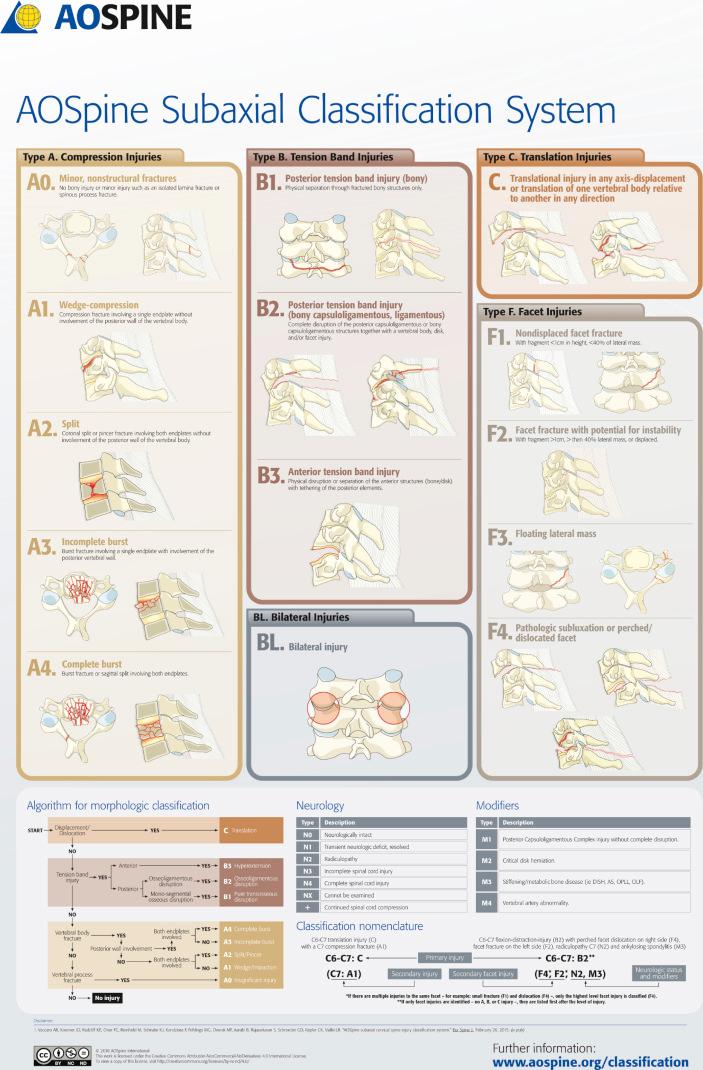
Cervical spine compression injuries (AOSpine type A) result from failure of the anterior column (vertebral body) and/or the posterior structures (spinous processes, lamina). Minor compression injuries result in soft tissue injuries or isolated lamina or spinous process fractures (AOSpine type A0). Vertebral body compression fractures that do not extend into the posterior wall of the vertebral body may involve a single endplate (AO type A1) or both endplates in a coronal split or pincer pattern (AO type A2). Burst fractures are compression-type injuries with extension into the posterior wall of the vertebral body with bony retropulsion into the spinal canal. Burst patterns may involve one (AOSpine type A3) or both endplates (AOSpine type A4).
A0: Minor, nonstructural fractures (no bony injury or minor injury such as an isolated lamina fracture or spinous process fracture). This category includes isolated lamina fracture, spinous process fractures, and transverse process fractures. Isolated laminar fractures in the absence of associated posterior element fractures or ligamentous rupture are uncommon and are likely to be caused by a direct blow or extension injury. The fracture extends through the lamina lateral to the facet joint/lateral mass and medial to the base of the spinous process. No subluxation or kyphosis should be present for this to be a truly isolated lamina fracture. Case reports have described isolated laminar fractures that displace ventrally into the spinal canal, causing spinal cord injury.
The classic spinous process fracture is the so-called “clay shoveler's fracture,” which occurs in the lower cervical and upper thoracic levels, typically C6, C7, or T1, and was first described in 1940 in Australian miners who experienced a pop and pain in the neck and upper back as the clay they were shoveling remained stuck to their shovels. Clay shoveler's fractures are thought to be avulsion injuries of the spinous process from the pull of the supraspinous ligament. These also commonly occur with motor vehicle accidents or during athletic events ( Fig. 32.5 ). Advanced imaging studies should be obtained to evaluate for soft tissue injury or other fractures in the cervical spine sustained during the trauma. The typical clay shoveler's fracture is oriented perpendicularly to the axis of the spinous process and directed inferiorly. However, a subtle radiographic finding, referred to as a spinolaminar breach, in which the fracture obliquely extends into the lamina, has been associated with delayed instability and a neurologic deficit. Radiologic evidence of a spinolaminar breach should prompt for an MRI to examine the status of the posterior ligamentous complex.
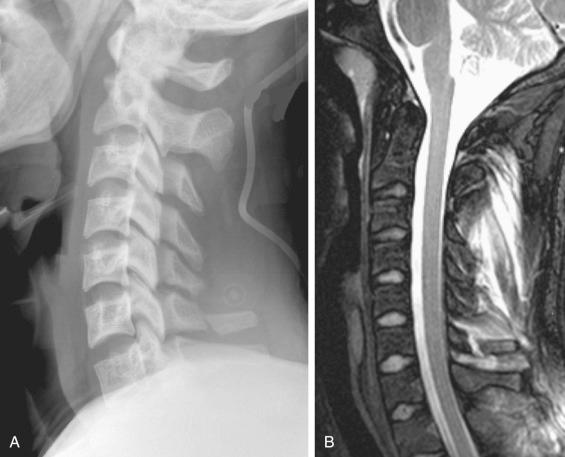
Transverse process fractures occurring in conjunction with other cervical spine injuries are relatively common. C7 is the most commonly fractured transverse process and is postulated to occur in motor vehicle accidents with modern shoulder-belt usage in which rapid deceleration causes an oblique hyperflexion moment. The main concern with an isolated transverse process fracture that extends into the foramen transversarium is injury to the vertebral artery. At the most commonly fractured level, C7, the vertebral artery normally has not yet entered the foramen transversarium.
A1: Wedge-compression (compression fracture involving a single endplate without involvement of the posterior wall of the vertebral body)
A2: Split (coronal split or pincer fracture involving both endplates without involvement of the posterior wall of the vertebral body). Although common in the thoracic and lumbar regions of the spine in osteoporotic individuals, compression fractures in the cervical spine occur less frequently. Typically, when they occur in the cervical spine, isolated compression fractures in the absence of ligamentous injury are due to low-energy mechanisms in osteoporotic individuals. Compression fractures can also occur in conjunction with a flexion-distraction injury mechanism and facet fracture-dislocation. Multiple cervical compression fractures may result in a progressive kyphotic deformity. With significant deformity affecting quality of life, surgical realignment procedures can be considered.
A3. Incomplete burst (burst fracture involving a single endplate with involvement of the posterior vertebral wall)
A4. Complete burst (burst fracture or sagittal split involving both endplates)
Burst fractures. Burst fractures involve a vertebral body fracture with loss of craniocaudal height and extension into the posterior vertebral body cortical margin. There is often retropulsion of bone fragments into the spinal canal. The mechanism of injury is initially pure axial loading. The most severe burst fractures with retropulsion have a high likelihood of spinal cord injury ( Fig. 32.6 ).
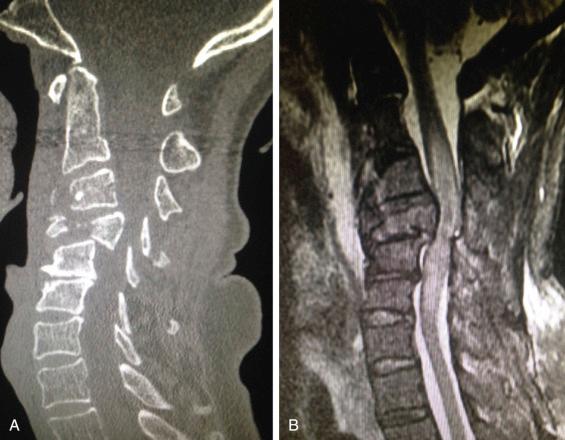
Tension band injuries (AOSpine type B) result from disruption of either the anterior or posterior tension band structures of the subaxial cervical spine without translation (AOSpine type C) of the injured vertebrae. A posterior tension band injury may involve bony structures alone (AOSpine type B1) or include associated capsular and ligamentous structures (AOSpine type B2). These injuries may extend anteriorly through the vertebral body or intervertebral disc. Type B1 purely bony posterior tension band injuries were the most uncommon injury pattern seen in a cervical spine trauma population at an academic medical center. Anterior tension band injuries involve disruption of either the intervertebral disc or body in an ankylosed spine (AOSpine type B3). These injuries maintain an intact posterior hinge, preventing vertebral translation. Displacement of the injured vertebrae with anterior and posterior tension band injuries is instead classified as translational (AOSpine type C).
B1. Posterior tension band injury (bony): physical separation through fractured bony structures only
B2. Posterior tension band injury (bony capsuloligamentous, ligamentous): complete disruption of the posterior capsuloligamentous structures together with a vertebral body, disc, and/or facet injury
B3. Anterior tension band injury: physical disruption or separation of the anterior structures (bone/disc) with tethering of the posterior elements. These injuries are often referred to as extension distraction injuries due to the injury mechanism, which causes disruption of the anterior column in the form of ALL and anterior annulus or ALL and transverse vertebral body fracture. An anterior osteophyte may also avulse from the anterior inferior vertebral body, often referred to as an “extension teardrop” fracture. The distraction injury may then propagate posteriorly, causing compressive fractures to the posterior elements or disrupting the posterior ligamentous complex, causing an unstable injury pattern.
Anterior tension band injuries typically occur in two distinct patient populations. They can be caused by high-energy mechanisms in younger patients. In elderly patients with cervical spondylosis, AS, or DISH, a low-energy mechanism, such as a ground-level fall or a blow to the face or forehead, can result in an anterior distraction injury, destabilizing the cervical spine and causing incomplete or complete quadriplegia. A retrospective study of 112 elderly patients with ankylosed spines who sustained this injury found that the 1-year mortality rate was 32% and that spinal cord injury was present in 58% of patients. Elderly patients without ankylosed spines but with cervical spondylosis may also sustain this injury pattern. This is a common scenario in the setting of a central cord syndrome, where the anterior distraction mechanism can cause a pincer-like mechanism of spinal cord injury due to canal narrowing between the posterior disc–osteophyte complex and in-buckled ligamentum flavum, even without frank disruption of the anterior column ( Figs. 32.7 and 32.8 ).
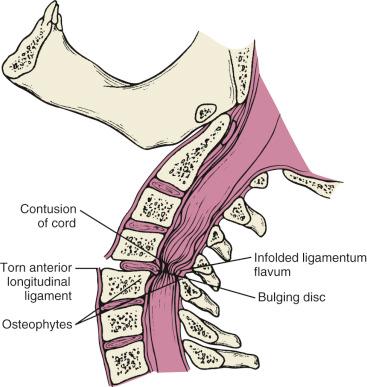
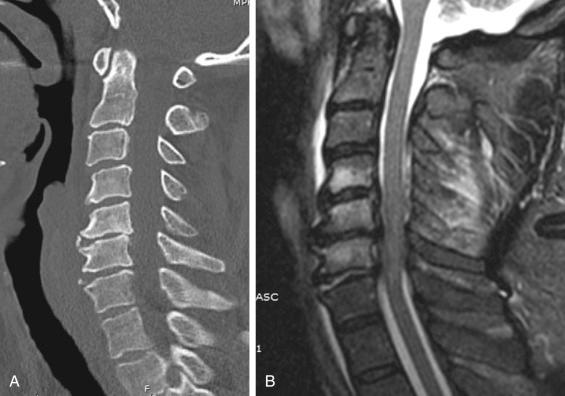
The spine is ankylosed or essentially fused in patients with AS and DISH, and it acts more like a long bone, resulting in a fracture between two long lever arms. Even in the absence of significant displacement, fractures in these patients are considered highly unstable and prone to displacement with movement. Because of the long lever arms above and below the fracture due to the fused spine, initially nondisplaced or minimally displaced fractures can easily become displaced, with resultant catastrophic neurologic injury. Often, due to the diffuse arthritis as well as extreme cervicothoracic kyphosis prevalent in some these patients, it may be difficult to recognize nondisplaced and potentially highly unstable fractures. Elderly patients with AS or DISH who present with neck pain even after a minor trauma should have a CT performed. MRI should be obtained if there is any question of a nondisplaced fracture. An epidural hematoma and concomitant neurologic deficit, which is associated with spinal fractures in the setting of an ankylosed spine, may be the most obvious imaging finding of an injury. Furthermore, the identification of an injury in the cervical spine should prompt advanced imaging studies of the entire spine because these patients are predisposed to noncontiguous fractures in other regions of the spine.
A translational injury is any axis-displacement or translation of one vertebral body relative to another in any direction. Translational injuries (AOSpine type C) occur with displacement of one vertebral body relative to another. Translation may occur in any direction (anterior, posterior, lateral, vertical) and is often associated with vertebral body or posterior element fracture (AO type C). Any associated type A or B injury with translation should first be classified as translational type C with subtype A or B in parentheses. There is no further subdivision of this injury pattern because all of these injuries are highly unstable. This category includes endplate compression fractures with facet fracture/dislocation, vertebral burst fractures with associated dislocation (flexion teardrop), unilateral facet fracture dislocations causing rotational displacement, and bilateral facet fractures and/or dislocation with discoligamentous disruption and translation ( Fig. 32.9 ).
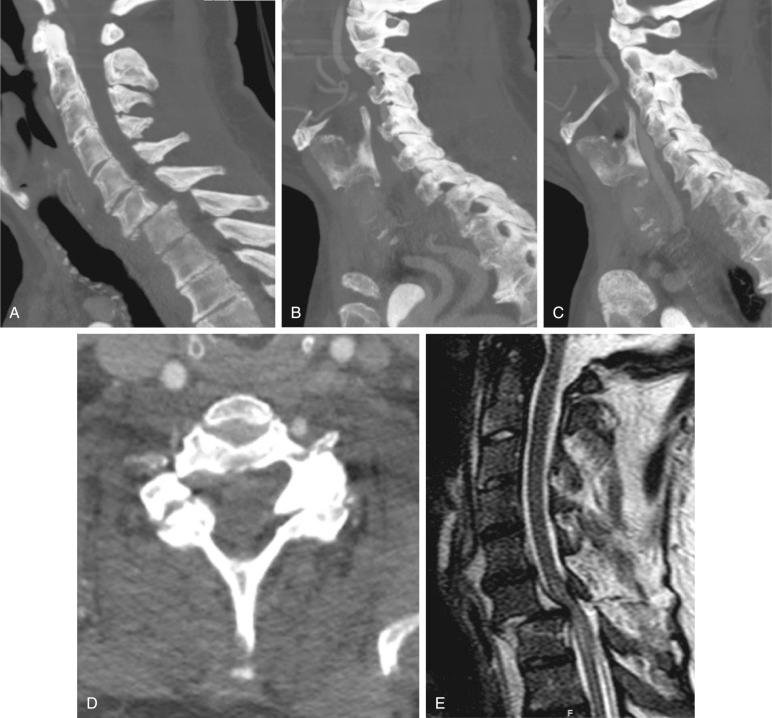
The integrity of the facet–joint complex is an important determinant of stability in subaxial cervical spine trauma. Injuries vary from minor nondisplaced fractures (AOSpine type F1) to displaced fractures with fragment greater than 1 cm or 40% of the lateral mass (AOSpine type F2), to facet injuries that result in a floating lateral mass (AOSpine type F3), to facet subluxation (AO type F4). Under the AOSpine Classification, if a similar subtype injury exists to both facets at the same level, the bilateral (BL) modifier is used. In the case of differing subtype injuries to the same vertebrae facets, the right facet is described first, followed by the left.
F1. Nondisplaced facet fracture: with fragment less than 1 cm in height, less than 40% of lateral mass
F2. Facet fracture with potential for instability: with fragment greater than 1 cm, greater than 40% lateral mass, or displaced. The differentiation between type F1 and F2 stems from the stability of the fracture itself. In 2006 Spector et al. retrospectively reviewed 24 patients with 26 unilateral facet fractures. They measured the height and width of the fracture fragment along with displacement and angulation. They calculated the height percentage compared with the contralateral intact facet. Five patients went on to have displacement and require surgery. Patients with unilateral facet fractures involving greater than 40% of the absolute height of the intact lateral mass or an absolute height greater than 1 cm (type F2) are at increased risk for failure of nonoperative treatment. Failure of nonoperative treatment was not observed in any patient with a fracture involving less than 40% of the height of the lateral mass or an absolute height less than 1 cm (type F1). Therefore this cutoff has been used to differentiate between type F1 and type F2.
F3. Floating lateral mass. A floating lateral mass is an ipsilateral fracture of both the lamina and pedicle, resulting in superior and inferior articular process fractures that are discontinuous from the native vertebrae ( Fig. 32.10 ). The injury likely occurs from a combination of extension, lateral compression, and rotation of the cervical spine, and the fracture line can extend into its superior and/or inferior facet, the foramen transversarium, transverse process, ventrally into the pedicle, or dorsally into the lamina. Lateral mass fractures often appear to be benign injuries, typically non- or minimally displaced, and the fracture may disguise an injury to the soft tissue. MRI is always indicated to fully evaluate the state of the soft tissues because subtle radiographic and CT findings often mask a disruption of the DLC in this injury pattern.
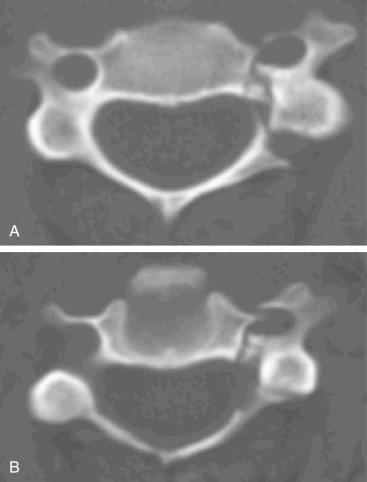
F4. Pathologic subluxation or perched/dislocated facet. The F4 injury pattern includes facet subluxations, unilateral facet dislocations, and bilateral facet dislocations. Facet subluxations are characterized by the misalignment of two adjacent vertebrae, resulting in less than full apposition of facet articular surfaces, which can be unilateral or bilateral. Facet dislocations are a disruption of a facet joint in which the inferior articular process of the cranial vertebra has translated anterosuperiorly over the superior articular process of the caudal vertebra. These also can be unilateral or bilateral. Perched facets demonstrate the tip of the inferior articular process abutting the superior articular process and have no facet articular surface apposition.
Cadaveric studies have shown that unilateral facet dislocations occur when the neck is flexed and bent laterally with subsequent axial torque. Another study showed that pure distraction applied unilaterally coupled with axial rotation creates enough force to cause a unilateral facet dislocation without the addition of a separate flexion moment. A cadaveric study of nine specimens in which unilateral facet dislocations or fracture-dislocations were created found facet capsular tears and annular disruption in all specimens. In eight specimens the ligament flavum was injured, whereas the interspinous and supraspinous ligaments were stretched in three and four specimens, respectively, but never completely torn. On CT a unilateral facet dislocation demonstrates a rotational deformity with reversal of the normal position of the superior and inferior facets at the dislocated level. The axial CT will show the inferior dislocated facet of the cephalad vertebra lying anterior to the superior facet of the caudal vertebrae. Sagittal CT scan will also reveal the typical appearance of the completely dislocated or perched inferior facet sitting anteriorly or on top of the caudal superior articular facet.
Bilateral facet injuries are caused by a flexion injury mechanism, either from a sudden deceleration in a motor vehicle accident or a fall onto the head in which the head flexes. The center of rotation of the flexion moment is anterior to the vertebral body, such that the posterior elements of the spine become distracted and fail. There is frequently a concomitant compressive force to the subjacent vertebral endplate. Bilateral facet dislocations have 50% or greater anterior translation of the dislocated vertebral body. Bilateral facet dislocations with only mild displacement on static imaging studies will often underestimate the degree of displacement at the moment of injury. A prospective observational cohort of 421 people presenting with traumatic cervical spinal cord injury found that patients presenting with acute spinal cord injury with an associated facet dislocation had worse neurologic recovery than those who presented without dislocation. Patients with bilateral facet dislocation had worse baseline neurologic function than patients with unilateral dislocations.
Pure distraction and flexion are likely to produce a pure dislocation of the facets ( Fig. 32.11 ). However, the flexion-distraction mechanism, combined with torsion, lateral bending, compression, or translation, may produce various combinations of fractures and/or dislocations of unilateral or bilateral facets ( Fig. 32.12 ). Often, the superior facet of the caudal vertebra is fractured and displaced into the foramen by the inferior facet of the cephalad vertebra. Patients may have a nerve root injury due to the fracture impinging on the nerve root in the neuroforamen. Laminae and spinous process fractures may also occur concurrently with this injury.
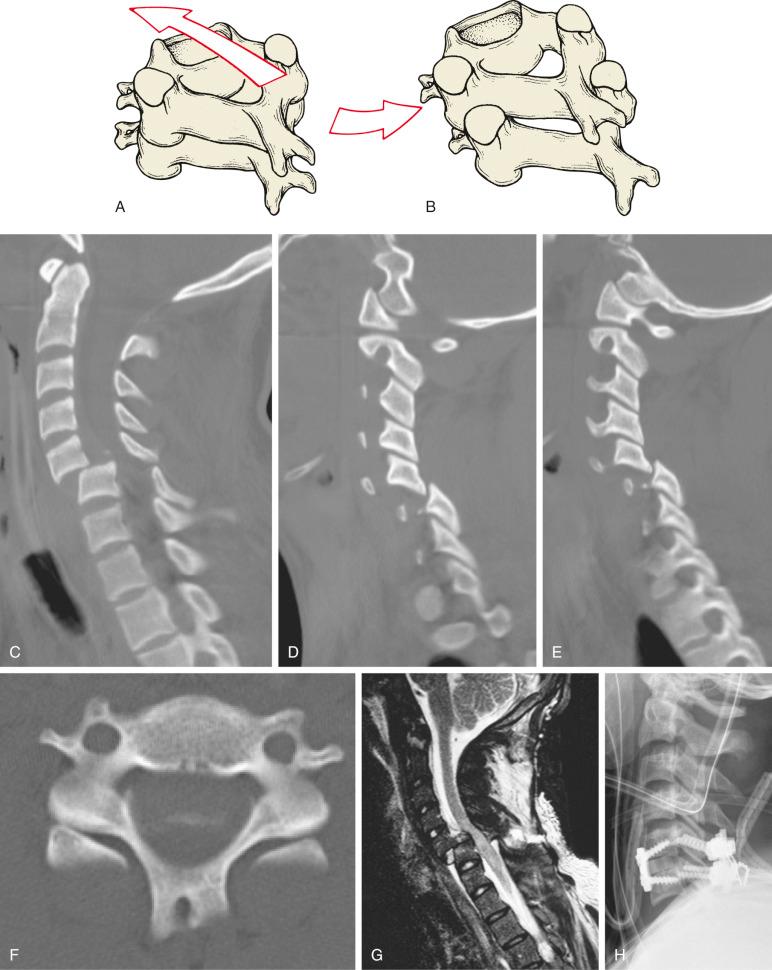
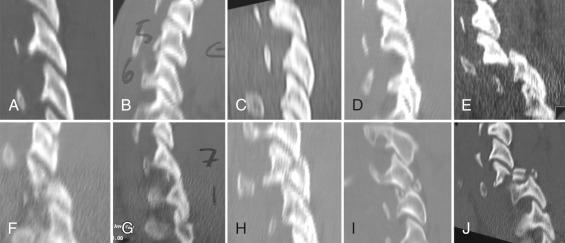
Neurologic status at the moment of admission should be scored according to the following scheme:
N0: Neurologically intact
N1: Transient neurologic deficit, resolved
N2: Radiculopathy
N3: Incomplete spinal cord injury
N4: Complete spinal cord injury
NX: Cannot be examined
Neurologic status is graded similarly to that of the thoracolumbar system. Injuries are described as neurologically intact (N0), transient neurologic deficit that has resolved (N1), presence of radiculopathy (N2), incomplete spinal cord injury (N3), complete spinal cord injury (N4), and undetermined status (NX). A “+” is given in the case of ongoing neurologic compression in the setting of incomplete deficit. The neurologic status modifier is determined based on the neurologic status of the patient at the time of admission. A full neurologic examination should be performed upon presentation and the American Spinal Injury Association (ASIA) scale documented ( Fig. 32.13 ). N0 is a completely neurologically intact patient. N1 is a patient with a transient neurologic deficit that has resolved on it its own. An example of this would be an American football player with congenital stenosis who sustains a transient quadriplegia event that resolves after a few seconds on its own. N2 is a patient with radiculopathy. These patients may have a disc herniation or a fracture fragment impinging on the nerve root. N3 is a patient presenting with an incomplete spinal cord injury. This encompasses Brown-Sequard syndrome, central cord syndrome, anterior cord syndrome, and posterior cord syndrome as well as the ASIA B, C, and D classifications. N4 is a complete spinal cord injury as defined by ASIA A with no motor or sensory function below the injury level without sacral motor or sensory sparing. NX characterizes when the neurologic status cannot be determined. This is often the case in patients with concomitant head injuries who are unresponsive or noncompliant with the neurologic examination.
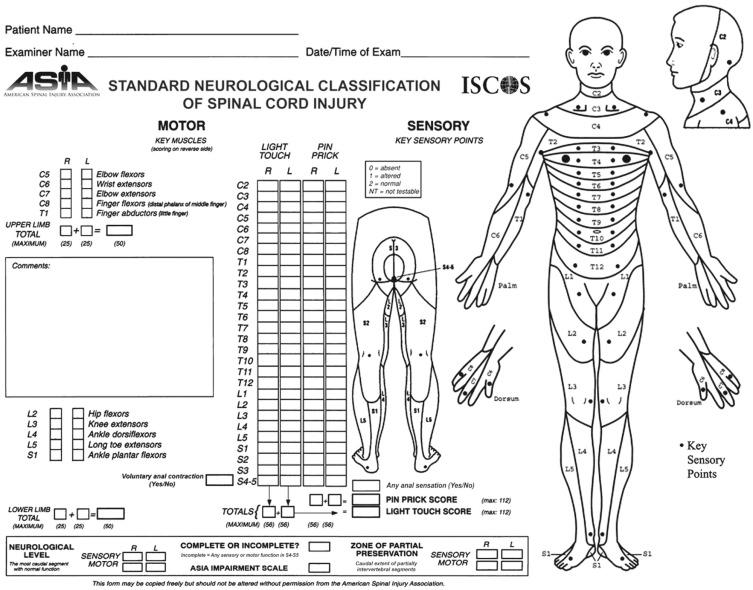
Case-specific modifiers are used to describe unique circumstances relevant to clinical decision making. These include injury to the posterior ligamentous complex (PLC; M1) as measured by MRI findings, injury morphology, and clinical evaluation. The PLC includes the facet capsule and supraspinous and interspinous ligaments. Additional modifiers include critical disc herniation (M2), metabolic/spondylotic bone disease (M3; DISH, AS, ossification of the posterior longitudinal ligament [OPLL], ossification of the ligamentum flavum [OLF]), and vertebral artery injury (M4).
In the past, the integrity of the facet capsule on MRI was used to help differentiate minor injuries from unstable injuries . However, studies have shown that injury to the posterior capsuloligamentous complex can be difficult to determine based on MRI. A survey of 529 spine surgeons from the different regions of the world found inconsistencies in diagnosing posterior ligamentous disruptions. The interobserver reliability of an international group of spine surgeons to identify an injury to the PLC in presumed thoracolumbar type A injuries without clear signs of posterior distraction is only slight (κ = 0.11), and there is a significant ( P < 0.001) regional variability in how their perception of the integrity of the PLC affects their choice of treatment. Therefore this modifier has been added when injury to the capsule and facets is seen on MRI but there is not definitive imaging of a complete disruption.
Critical disc herniations constitute a modifier because they often result in spinal cord injury and neurologic deficit. The presence of a critical disc herniation may determine both timing and treatment considerations.
Become a Clinical Tree membership for Full access and enjoy Unlimited articles
If you are a member. Log in here